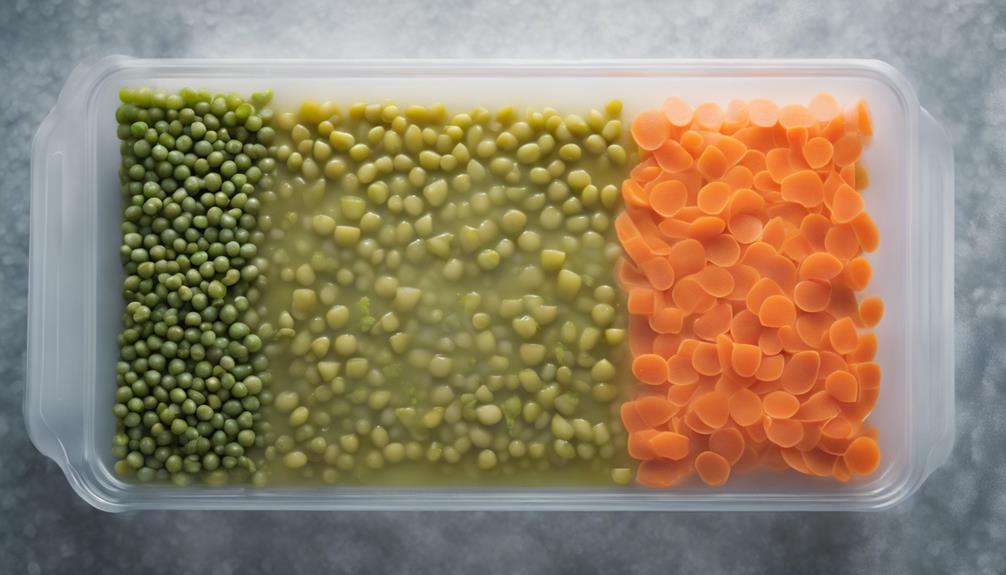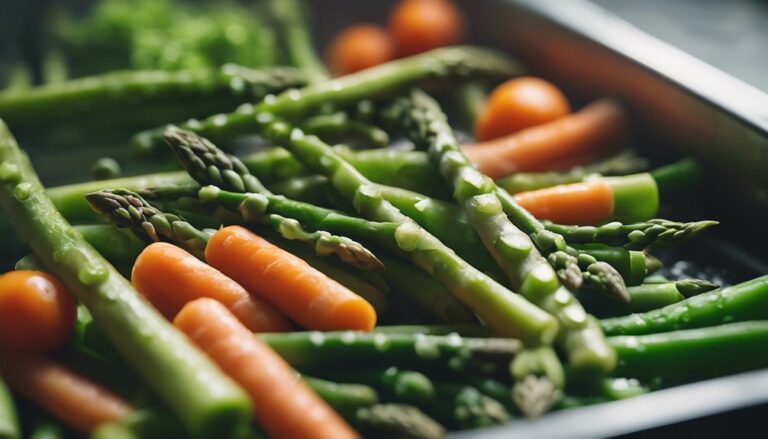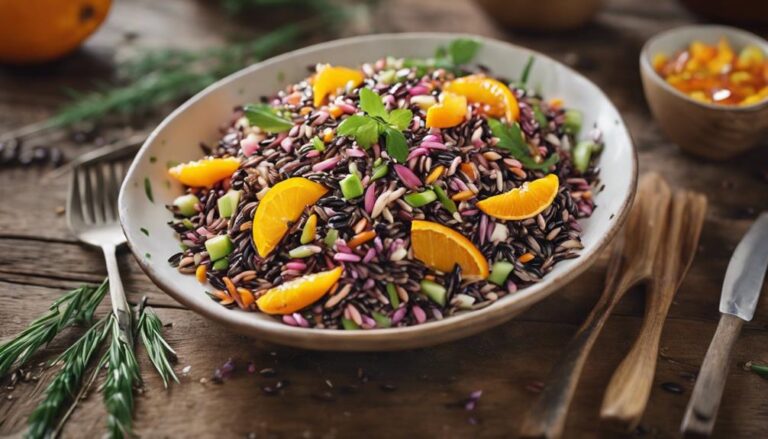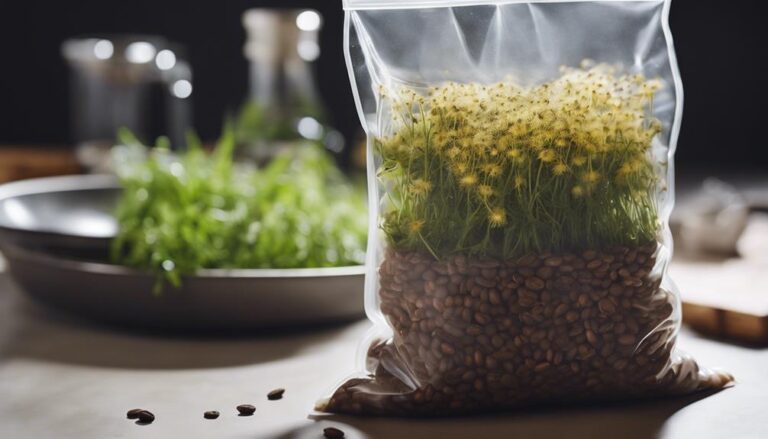Sous Vide Split Pea Soup With Root Vegetables
Experience the sous vide split pea soup with root vegetables for a culinary delight. Achieve perfection with tender split peas and a medley of root veggies cooked to precision. Revel in the rich flavors and textures this dish offers, a comforting blend of earthy goodness. Enhance your soup game with this scrumptious recipe that promises to captivate your taste buds. Embrace the aroma and savor the taste of each meticulous ingredient. Discover the secrets to a remarkable soup that will leave you yearning for more.
What You Will Learn Here
- Sous Vide method ensures precise temperature control for perfectly cooked split pea soup.
- Root vegetables like carrots and parsnips add nutrition and depth to the dish.
- Immersion circulator setup is crucial for even cooking and flavor infusion.
- Slow cooking in Sous Vide enhances flavors and textures for a velvety soup.
- Using a hand blender can create a smooth and creamy texture for the soup.
Origins of Pea Soup

Pea soup has a rich history that stretches back to ancient Greece and Rome, where it was a staple dish. Traditional ingredients like split peas and root vegetables are commonly used to make this hearty soup.
Regional variations of pea soup can be found worldwide, each adding its own unique twist to this comforting and timeless dish.
Pea Soup History
With roots tracing back to ancient times in Greece and Rome, the history of pea soup reveals a culinary tradition rich in heritage and flavor. Split pea soup gained popularity in Northern Europe during the Middle Ages, becoming a beloved dish known for its simplicity and nourishing qualities. This hearty soup has been a staple in many cultures, showcasing variations that highlight regional ingredients and cooking techniques. Traditional pea soup recipes often feature legumes like peas or beans, providing a source of protein and fiber. Whether enjoyed as a comforting winter warmer or a summertime chilled delight, pea soup continues to be a versatile and satisfying dish that has stood the test of time.
| Ancient Roots | Middle Ages | Global Influence |
|---|---|---|
| Greece and Rome | Northern Europe | Regional Variations |
| Culinary Tradition | Popular Dish | Diverse Ingredients |
| Heritage & Flavor | Hearty Qualities | Cultural Significance |
Traditional Ingredients Used
Tracing the culinary lineage of split pea soup back through the annals of history reveals a tapestry interwoven with diverse root vegetables and aromatic seasonings that have shaped this beloved dish into a nourishing culinary tradition.
Split peas, the star ingredient, provide a rich source of protein and fiber, essential for a hearty soup. Alongside split peas, onions, carrots, and celery form the classic trifecta of flavors, enhancing the earthy notes of the soup.
The addition of ham or other meats introduces a savory depth, elevating the dish to a comforting meal. Root vegetables like parsnips and celery root not only contribute to the soup's robust flavor profile but also offer a nutritional boost, enriching each spoonful with vitamins and minerals.
Regional Variations Observed
Originating in Northern Europe, particularly in countries like the Netherlands, Sweden, and Finland, regional variations of pea soup showcase the diverse culinary preferences and traditions unique to each nation.
In the Netherlands, Erwtensoep is often prepared with a distinctive addition of smoked ham hock, providing a rich and savory flavor profile to the dish.
Swedish ärtsoppa traditionally includes a ham bone or salted pork for added depth and richness, complementing the earthy sweetness of the peas.
Finnish hernekeitto also incorporates ham or smoked bacon, enhancing the overall taste with a hint of smokiness.
These variations highlight the importance of ham in Northern European pea soups, adding a delicious complexity that elevates the hearty and comforting nature of this traditional dish.
Key Ingredients for Authentic Flavor
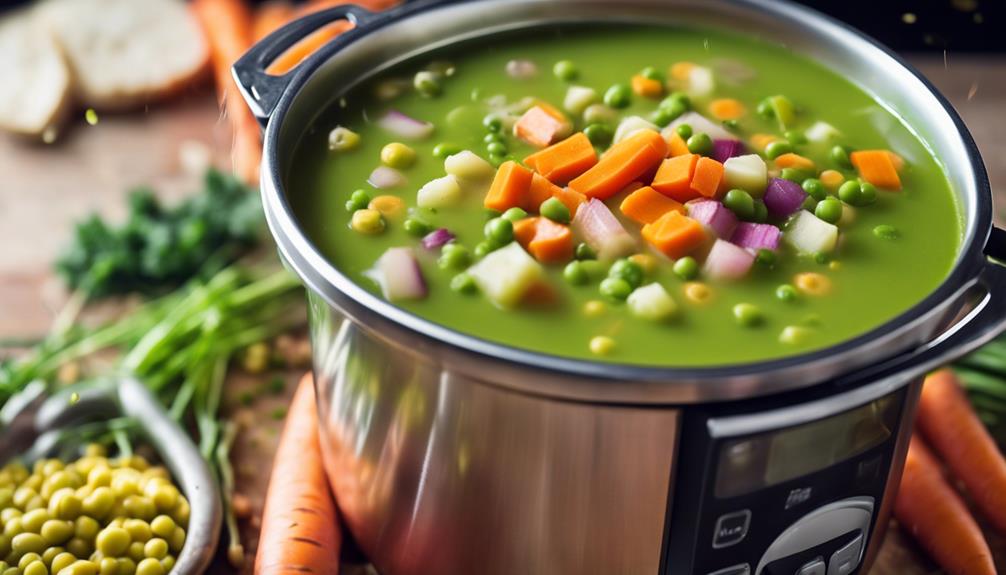
To truly capture the authentic essence of a flavorful split pea soup with root vegetables, it's essential to carefully select and incorporate key ingredients that form the foundation of this beloved dish.
When aiming for an authentic flavor profile, consider the following key ingredients:
- Ham Hock: The use of ham hock is pivotal in infusing the soup with a rich, smoky flavor that elevates the overall taste experience. The ham hock imparts a depth that's quintessential to traditional split pea soup recipes.
- Split Peas: These legumes aren't just a base ingredient but a star player in the dish. They break down during cooking, creating a creamy texture that binds the soup together while adding a robust, earthy flavor.
- Root Vegetables: Onions, carrots, and celery aren't mere accompaniments; they're essential components that contribute a sweet and savory balance to the soup. The combination of these root vegetables enhances the overall complexity of flavors, making each spoonful a delight.
Top-Rated Pea Soup Variations
You've got some exciting pea soup variations to explore, including Sous Vide Dutch Pea Soup for a modern twist, Savory Smoked Ham Pea Soup for a rich and smoky flavor, and Hearty Pea and Bacon Chowder for a comforting and filling option.
Each variation brings its own unique blend of ingredients and preparation methods, offering a range of textures and tastes to suit your preferences. Whether you're a fan of traditional recipes or looking to try something new, these top-rated variations are sure to delight your taste buds.
Sous Vide Dutch Pea Soup
When preparing Sous Vide Dutch Pea Soup, the precise temperature control of the sous vide method guarantees that the flavors of the root vegetables are maximized while retaining essential nutrients. This method ensures that each vegetable piece is cooked to perfection, creating a harmonious blend of flavors in every spoonful.
Here are three reasons why Sous Vide Dutch Pea Soup stands out:
- Consistent Results: The sous vide technique provides consistent cooking throughout the soup, avoiding any unevenly cooked or mushy vegetables.
- Enhanced Flavors: By cooking at a precise temperature, the natural flavors of the root vegetables are intensified, resulting in a rich and flavorful Dutch pea soup.
- Nutrient Retention: The sous vide cooking method helps to maintain the nutrients present in the ingredients, ensuring a wholesome and nutritious meal for you to enjoy.
Savory Smoked Ham Pea Soup
Sous Vide Dutch Pea Soup harnesses the precision of the sous vide method to amplify the flavors of root vegetables, paving the way for a savory Smoked Ham Pea Soup variation that promises depth and richness with every spoonful. Using a ham bone in this soup brings a smoky essence that infuses the entire dish with a delightful aroma and taste.
Here are three key reasons why this Smoked Ham Pea Soup stands out:
- The ham bone adds a robust and savory undertone that complements the sweetness of the peas.
- The slow cooking process allows the flavors to meld together, creating a harmonious and rich soup.
- High-quality smoked ham elevates the dish, turning it into a gourmet experience that's sure to impress.
Hearty Pea and Bacon Chowder
Looking to elevate your pea soup game with a touch of savory richness and a smoky essence? The Hearty Pea and Bacon Chowder is a top-rated variation that combines the flavors of split peas and bacon to create a comforting and indulgent dish. Here's why this chowder is a must-try:
- Rich Flavor: The addition of bacon in this split pea chowder offers a depth of flavor that complements the sweetness of the peas, creating a rich and satisfying taste experience.
- Smoky Element: The bacon brings a smoky essence to the chowder, adding a deliciously savory and meaty component that enhances the overall profile of the soup.
- Crowd-Pleaser: This hearty pea and bacon chowder is sure to be a hit with your guests, making it an excellent choice for a warming and filling meal option.
Sous Vide Timing Suggestions
When it comes to sous vide timing for split pea soup with root vegetables, understanding the cooking time recommendations, temperature precision tips, and equipment setup guidance is essential.
The ideal cooking time ranges from 8-12 hours at 185°F, ensuring a perfectly cooked and flavorful soup.
Cooking Time Recommendations
For optimal texture and flavor in your split pea soup, consider cooking it sous vide for 8-12 hours at 185°F (85°C). This technique guarantees that the soup is evenly cooked throughout, resulting in a velvety smooth texture and intense flavors. Unlike traditional cooking in a Dutch oven, sous vide cooking offers precise temperature control, preventing overcooking or undercooking of ingredients. The extended cooking time allows the flavors to blend together beautifully while retaining the nutrients in the soup. Here is a useful table to assist you with the cooking time recommendations for your sous vide split pea soup:
| Cooking Time | Texture and Flavor |
|---|---|
| 8 hours | Tender and flavorful |
| 10 hours | Creamy and rich |
| 12 hours | Ultra-smooth and intense |
Temperature Precision Tips
To guarantee precise temperature control and ideal cooking results for your sous vide split pea soup with root vegetables, closely monitor and adjust the temperature throughout the cooking process.
Sous vide cooking relies on maintaining a consistent temperature to make certain that the split peas and root vegetables are cooked evenly and retain their flavors. Keep an eye on the sous vide equipment to prevent fluctuations that could impact the outcome of your soup.
Equipment Setup Guidance
For ideal equipment setup guidance in sous vide cooking, make sure your immersion circulator is securely attached to your cooking vessel to maintain consistent temperature control.
Before starting the sous vide process for your split pea soup with root vegetables, drizzle a bit of olive oil over the vegetables to enhance their flavors during the long cooking time. This step helps the vegetables develop a rich taste and prevents them from sticking together.
Final Thoughts
Considering the rich flavors and essential preparation that Sous Vide cooking brings to this split pea soup recipe, it's clear that this technique elevates the dish to a new level of culinary excellence.
The use of a hand blender at the end of the cooking process is vital for achieving that velvety smooth texture that makes this soup so delightful.
The slow cooking method in the Sous Vide guarantees that the flavors from the root vegetables and split peas meld together perfectly, creating a depth of taste that's hard to achieve through traditional cooking methods.
Moreover, the precise temperature control of Sous Vide cooking guarantees that your split pea soup will be cooked to perfection every time, with minimal hands-on time required from you. This makes it an ideal dish for those who desire to serve a delicious and nutritious meal without spending hours in the kitchen.
Frequently Asked Questions
Why Are My Split Pea Soup Peas Not Softening?
If your pea texture is off, hard water, cooking time, and older peas might be culprits. Avoid adding acidity early; opt for a pressure or slow cooker. Keep ingredients fresh. Adjust and guarantee softening for perfect split pea soup.
Why Did My Split Pea Soup Get so Thick?
If your split pea soup turned thick, it's likely due to overcooked peas and excess veggies. Adjust liquid amounts, stir often, and mind cooking time for ideal pea texture. Control thickness by managing broth levels and cooking techniques.
How Do You Add Flavor to a Bland Split Pea Soup?
To boost the taste of bland split pea soup, try adding flavorful seasonings like smoked paprika, cumin, or fresh herbs. Enhance the umami with ingredients like soy sauce and miso paste. Roasting root vegetables can also elevate the dish.
What Is the Difference Between Split Pea Soup and Pea Soup?
When differentiating between split pea soup and pea soup, consider that split pea soup specifically uses dried split peas for its base, creating a thicker consistency. Pea soup, on the other hand, encompasses a broader category of soups made with various pea varieties.
Conclusion
Indulge in the rich and flavorful experience of sous vide split pea soup with root vegetables. By cooking the ingredients slowly and at a precise temperature, you're able to achieve a perfect balance of flavors and textures.
This dish isn't only comforting and satisfying, but also a great way to showcase the natural sweetness of the peas and root vegetables. Treat yourself to a bowl of this delicious soup and savor every spoonful.
